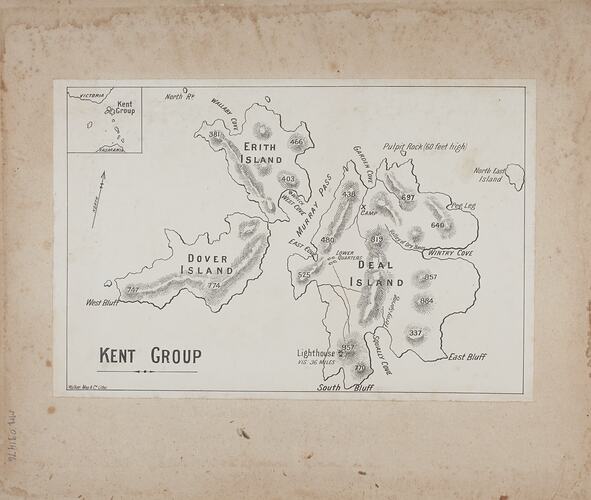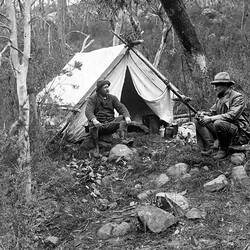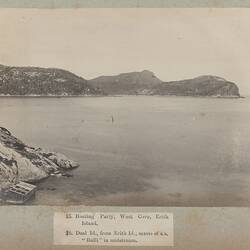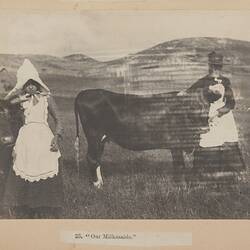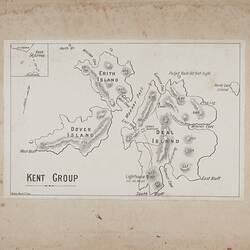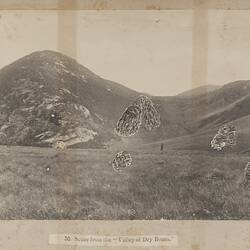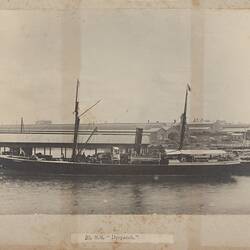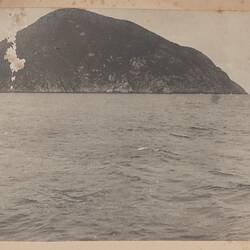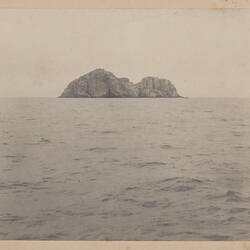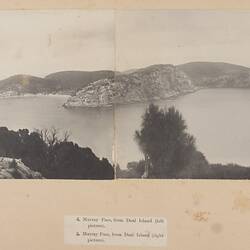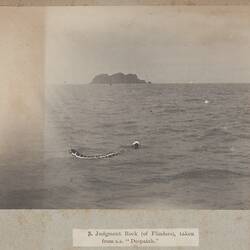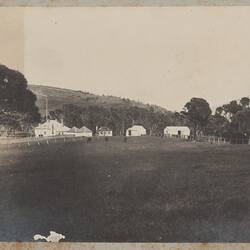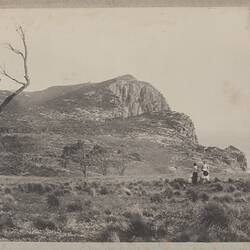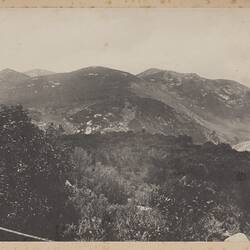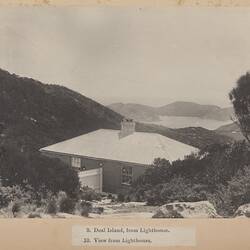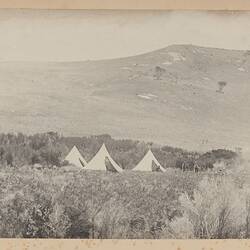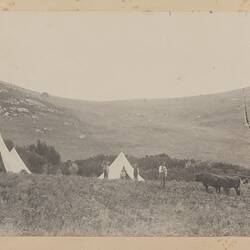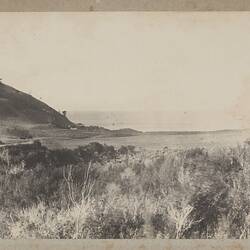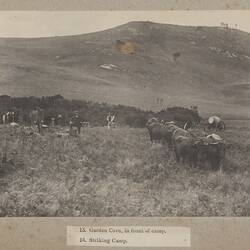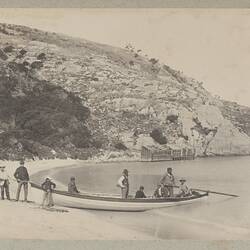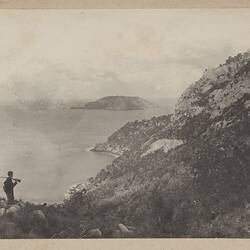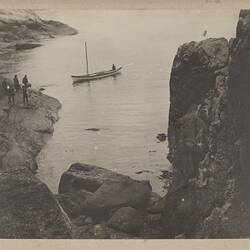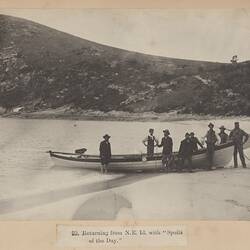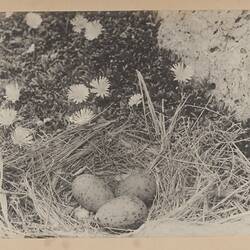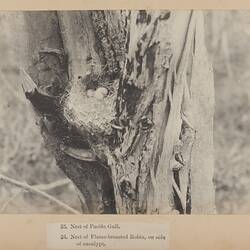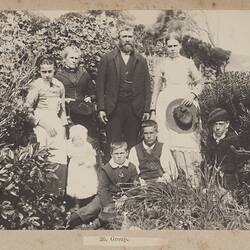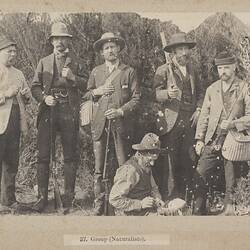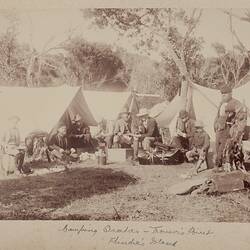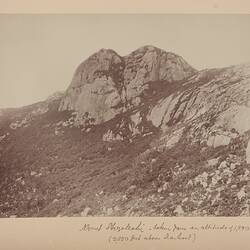OUR VISIT TO KENT GROUP BY ONE OF THE FIELD NATURALISTS' PARTY
The visit of the field naturalists to Kent Group will doubtless be long remembered by the inhabitants - the three lighthouse-keepers and their families - who reside upon the largest (Deal) Island. They are almost entirely cut off from speaking communication with the world, yet much of the shipping traffic of the southern colonies may be said to pass within view of the lighthouse. During our brief sojourn it was a common sight to see one or two sails or a steamer's smoke upon the horizon, and on the morning of our departure a four-masted ship, with every stitch of canvas spread, passed southward.
Most of the lighthouses in Bass Straits are under the jurisdiction of Tasmania. The Marine Board at Hobart formerly despatched a vessel with stores three times a year, but the visit is paid quarterly, in February, May, August, and November. The vessel only remains a few hours, to land stores and to allow the inspector to examine the apparatus and quarters, the islanders barely having time to answer correspondence. Each light-keeper is supposed to have a fortnight's annual leave, but the members of the staff on Deal Island are only relieved once in three years, then receiving six weeks' holiday a-piece. In the long intervals between the visits of the inspecting vessel there is little to break the monotony of the every-day routine of cleaning, lighting, and putting out the lamps. When some marine casualty occurs or a vessel is missing a stranger may be put in quest of information, or a pleasure yacht or sealer's boat may occasionally call. One morning a sealer's craft arrived in East Cove, but when the crew learned that a party of naturalists from Victoria was upon the island, they departed as suddenly as they appeared. It was the close season for sealing, and the motive for their departure can easily be guessed. Young seals were being born at Judgment Rock near by.
When a vessel turns up at Deal Island for information, the missing ship she comes to inquire about is generally considered a hopeless case. For instance, in 1858, H.M. brig Sappo, bound from England to Sydney, was missing. All the Government search vessel could glean was that the man-of-war was last seen off Deal Island during a gale. Not a soul on board ever turned up, and the circumstances of her fate are unknown. About 18 or 20 years later the Port Albert pilot schooner came in quest of tidings of the barque Essie Black, from Newcastle to Melbourne. The barque was never heard of, but portions of the stern bearing her name were found somewhere in Murray Pass. In 1890 the S.S. Lady Loch explored the group in search of the May Jennings, a ketch, from Penguin Creek, Tasmania, to Sydney, which has never been found.
The principal lightkeeper's spare time is spent in gardening. About the house we saw many familiar and hardy-looking plants, while in different parts of the island, sheltered by tall ti-tree, are kitchen gardens, which, with a sufficient annual rainfall (32in. was registered last year), yield abundance of vegetables.
Cattle thrive upon Deal Island, and the supply of butter and milk is greater than the consumption. The quantities of rich fresh milk, not to mention custards that were sent to our camp are items to be long remembered. Some of the cows are exceedingly quiet, and suffer the girls to place their arms about their necks when browsing in the paddock. One of the young women requested us as a favour to photograph her in the field as she stood by the side of her favourite cow. The artist jumped at the chance, and the picture made his collection complete. The bullocks are kept to draw stores from the landing place to the lighthouse - a distance of about two miles, with an ascent of over 900ft. Hardy old mariners tell us of the black bulls they saw at the station years ago.To-day we find black bulls and black bullocks as fat and sleek as ever were yoked. A few sheep thrive upon the island.
Much of the light keepers' time is occupied in reading, especially during the long watches of the winter night. The Hobart Marine Board is thoughtful in this way, and gladly forwards any literature which may be directed to the station. The shipping companies willingly carry to Hobart, free of charge, any parcels of books and periodicals which may be directed to the light keepers, care of the Hobart Board. Any one having a few books to give away has an opportunity to do the occupants of Deal Island a good turn. The Victorian Government provides each of their light keepers with a library, chiefly replenished with donations from Messrs. Melville, Mullen, and Slade.
Sickness is almost unknown in the group. A few graves dot the islands, but, strange to say, they are mostly those of visitors. There is one sacred spot near the lighthouse - evidently the grave of a child. It is overgrown wit sweet peas all in bloom. Fierce storms sometimes pass across the straits, and focus about the high land of Kent Group. The lighthouse, although itself only 45ft. high, stands 1,000ft. above the sea, and has been struck more than once by lightning. Some years ago the granite tower was struck, and portion of the inside fittings torn away.
By way of diversion and to obtain fresh food the inhabitants frequently go fishing. We joined them, spending two very pleasant as well as profitable evenings with the seine in Garden Cove, opposite our tents. After tea one of our number went to the quarters and assisted the principal keeper and his son to bring the boat round, a good pull of about two miles. On their arrival the rest of our party joined in. The day had been charmingly fine, and was succeeded by a lovely night. The moon, in her first quarter, had sunk behind the surrounding hills, which stood clearly defined against the star-lit sky. We heard the weird cries of penguins calling to each other or wrangling in their burrows. Our first essay with the net produced a good haul. By the dim light of our lanterns we found we had secured about 200lb. Weight of fish, chiefly salmon, trevalla, mullet, skipjacks, &c. All hands had more fish than they required, therefore one haul was sufficient that night. On a subsequent evening our success was not so great, but we greatly enjoyed the fun of lying out and hauling in the net in the moonlight, and the supper by the fire afterwards.
By the kind permission of the Marine Board, Hobart, we manned the whaleboat (the principal light keeper - a hardy old Norseman - being in charge), and went to N.E. Isle, the abode of numerous seafowl, whose haunt has not been disturbed for years. We have a strong pull of about four miles. The illustration will show that we could not have landed if the sea had not been smooth. The islet is a huge rock, a mile across, with beetling walls all rounds. With what delight we scrambled up its sides and explored out-of-the-way nooks and corners where birds were sitting. A drawing is given of the summit of the rock. One of the parties was here attacked by a pair of falcons, which were protecting an eyrie occupied by their downy young. Before quitting the rock we photographed the nest of a Pacific gull on a rocky ledge. It contained three eggs, and was gracefully surrounded with white-flowering pig-face weed.
An article describing the scientific results of our expedition has already appeared in The Australasian and a detailed statement is given in the current number of the Naturalist, the journal of the Field Naturalists' Club. The occupants of the island seemed very sorry when the time came for us to leave - no wonder, for they will see no visitors till February. Our expedition made a break in the dull and lonely life they have to live. We noticed that the girls stole behind a bush to hide their tears. Young people naturally feel the want of companionship more than their elders, who have passed through the buoyant period of existence, and have work and responsibility to occupy their thoughts with. Would it be possible for their fortunate sisters on the mainland, who are weary of too much society, to send these young people an occasional remembrance? I wonder if they ever receive Christmas cards? But the vessel makes no call between November and February.
All the illustrations are from photographs by a member of the expedition. Rodondo, 1,150ft. high, is a majestic granite cone, situated seven miles due south of Wilson's Promontory. Devil's Tower, 350ft. high, is a queer pile of rocks between Rodondo and Kent Group. The pretty nest on the clef of a stunted eucalypt is that of the flame-breasted robin, a bird which is familiar about Melbourne gardens in winter time, and appears to retire to isolated places, like the islands in Bass's Straits, to breed.
More Information
-
Keywords
-
Authors
-
Contributors
-
Article types
